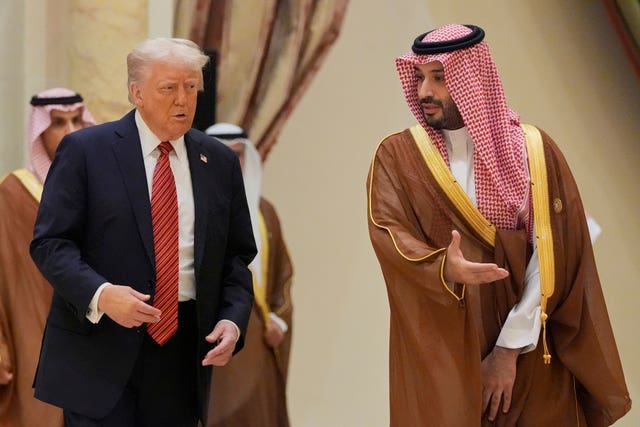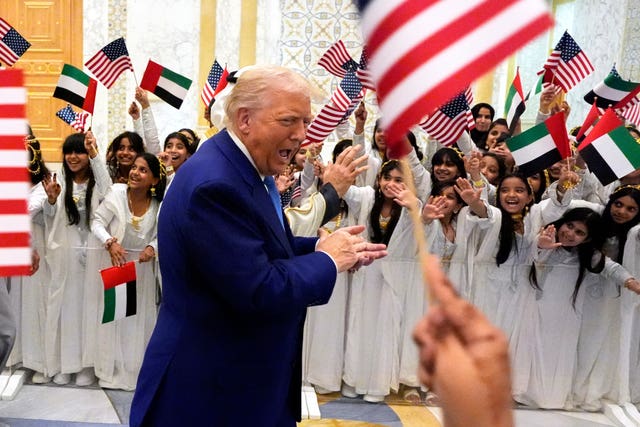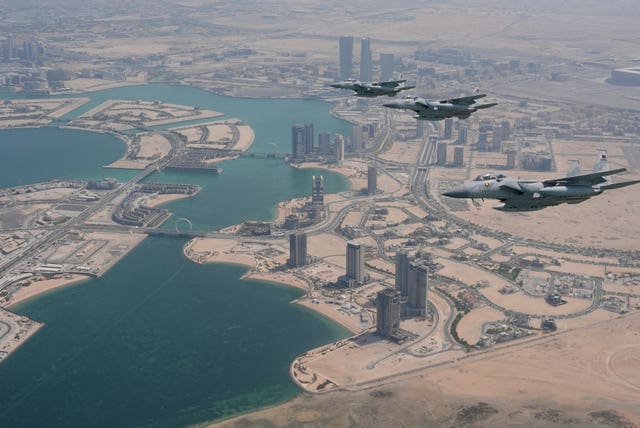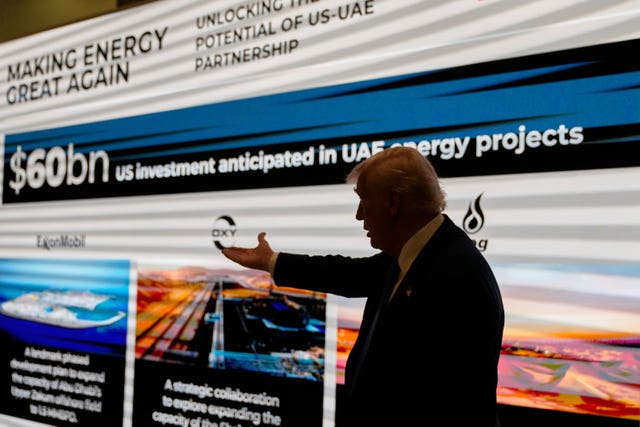Opulence and business deals among takeaways from Trump’s Middle East tour
Mr Trump’s four-day swing through Saudi Arabia, Qatar and the UAE put a spotlight on the US president’s transactional approach to foreign affairs.

US President Donald Trump used the first major foreign trip of his second term to outline a vision for restoring global stability that is grounded in pragmatism and self-interest rather than values, holding out ties to wealthy Gulf countries as a model for America’s long-time foes.
Mr Trump’s four-day swing through Saudi Arabia, Qatar and the UAE, which ends on Friday, put a spotlight on his transactional approach to foreign affairs as he was feted by autocratic rulers with a trio of lavish state visits where there was heavy emphasis on economic and security partnerships.
His trip played out against the backdrop of stubborn global conflicts, including Gaza and Ukraine, that showed the limits of his influence.

But Mr Trump insisted he was turning the page on American “interventionalism” in the region as he moved to recognise the new government in Syria for the first time and prodded Iran to engage on nuclear talks before it is too late.
Here are some takeaways from Mr Trump’s travels.
– Trump marvelled at Gulf state opulence but held his tongue on human rights
Presidential trips to the Middle East usually feature at least some public calls for authoritarian governments to improve their human rights efforts.
Not this one, as Mr Trump celebrated his business deals with Gulf royals and admired their wealth.
Mr Trump toured the marble and gilded palaces of Gulf rulers and deemed them “perfecto” and “very hard to buy”.
He praised the “gleaming marvels” of the skyline in Saudi Arabia and he groused about the “much less impressive” Air Force One.
In Mr Trump’s remarks at a VIP business conference in Riyadh, he went out of his way to distance himself from the actions of past administrations, the days when he said American officials would fly in “in beautiful planes, giving you lectures on how to live and how to govern your own affairs”.
Rights advocates took that as a pledge of non-intervention, swearing off some of the pressure past US presidents have brought to bear on partners to varying degrees to ease up on detentions, suppression of critics and other issues.
“It’s absolute support for absolute monarchy,” said Saudi exile Abdullah Alaoudh.

His father, a Saudi cleric with a wide following there, is imprisoned in the kingdom.
– Thwarted by Putin
While Mr Trump was in the Middle East, Vladimir Putin opted to skip direct peace talks with Ukraine’s Volodymyr Zelensky despite the US president’s strong calls for them to meet face-to-face.
Mr Trump has been pushing Mr Putin and Mr Zelensky to move with greater haste to end Russia’s grinding war in Ukraine.
But after it became clear Mr Putin would not be attending talks in Turkey this week and would instead be sending underlings to Istanbul, an annoyed Mr Trump insisted he knew all along that it was highly likely Mr Putin would be a no-show.
“I don’t believe anything’s going to happen whether you like it or not, until he and I get together,” Mr Trump said. “But we’re going to have to get it solved because too many people are dying.
Mr Trump was scheduled to fly back to Washington DC on Friday, but tried to keep people guessing until the end.
He teased late on Thursday that he would be heading to a “destination unknown” — “probably” Washington, he added.
His opaque language stoked speculation that he might make a drop-by to Turkey.
– On Syria sanctions, Trump takes a leap of faith
Just two months ago, the Trump administration was not sold on Syria’s interim government led by Ahmad al-Sharaa, the onetime al-Qaida-affiliated insurgent.

They worried the Syrian president did not have the legitimacy to govern the country’s ethnically diverse population.
Clashes broke out in early March, killing hundreds and targeting many more members of the Alawite religious minority to which the ousted Syrian leader Basher Assad belongs.
The moment gave the Trump White House pause about easing sanctions on Syria.
But Mr Trump signalled on Monday that he was having a change of heart and was moving toward lifting the Syria sanctions and a day later, he announced the move during an address to Gulf leaders.
Mr Trump then took it another step by agreeing to meet al-Sharaa.
He said he was impressed with Mr al-Sharaa, who not that long ago had a 10 million dollar US bounty on his head.
The president called him a “young, attractive guy” with a “very strong past”.
Mr Trump said it was recommendations from Turkish President Recep Tayyip Erdogan and Saudi Crown Prince Mohammed bin Salman that nudged him to take a chance on Mr al-Sharra.
– Trump’s fuzzy maths on display
Throughout the trip, Mr Trump felt more than comfortable dishing out exaggeration and hyperbole.

“This has been an amazing trip,” Mr Trump told reporters on Thursday as Air Force One was about to land in Qatar.
“We’ve raised trillions of dollars of investment for our country.”
A little later he put the figure at four trillion dollars.
That figure is about two times the combined gross domestic products of Saudi Arabia, Qatar and the UAE, meaning that any announced investments would likely accrue over several years — if at all — in ways that might not show up in overall US economic growth numbers.
Boeing confirmed that Qatar’s 96 billion dollar purchase of its 787 and 777X jets was the largest order for 787s and wide body jets in the company’s history.
Mr Trump enthused it was “the biggest order in the history of, I think, aviation, certainly of that size” of jets.
Mr Trump also went overboard in running down the economic record of his predecessor, Democrat Joe Biden, at one point declaring: “The days of economic misery under the last administration are rapidly giving way to the greatest economy in the history of the world.”
The US economy grew at 2.8% last year but it declined at an annualised rate of 0.3% during the first three months of this year.
– Intractable conflicts remain just that
While Mr Trump’s trip initially was conceived as a visit to reward countries that invest in the US, Mr Trump at one point hoped it also would herald significant steps to end the wars in Gaza and Ukraine.
Positive news on both fronts proved elusive.

Mr Trump barely mentioned either conflict on his trip – and when he did, it was generally in the context of his assertion that they would not have occurred had he won re-election in 2020.
As Israel stepped up an offensive in Gaza — a prelude to a promised full takeover of the territory if Hamas does not release the remaining hostages in its captivity — Mr Trump was again musing about the creation of a “freedom zone” in its territory.
It is a notion rejected by Palestinians and the broader Arab world because Mr Trump’s plan would relocate civilians from Gaza to allow for rebuilding.
Israel conducted significant airstrikes all week in Gaza as Mr Trump was in the region and the fighting on the ground appeared to escalate Friday morning even before Trump left the UAE.
– Ethics issues follow along as Trump travels the Middle East
Mr Trump was already facing questions about conflicts of interest for travelling to the Middle East to shape US policy at a time when his family’s business interests in the region have boomed.
He attempted to quiet worries about national security and constitutional questions by insisting he’s smart to accept a 400 million dollar luxury plane from Qatar and use it as Air Force One.
“Why should our military, and therefore our taxpayers, be forced to pay hundreds of millions of dollars when they can get it for FREE,” Mr Trump posted on his social media site.





